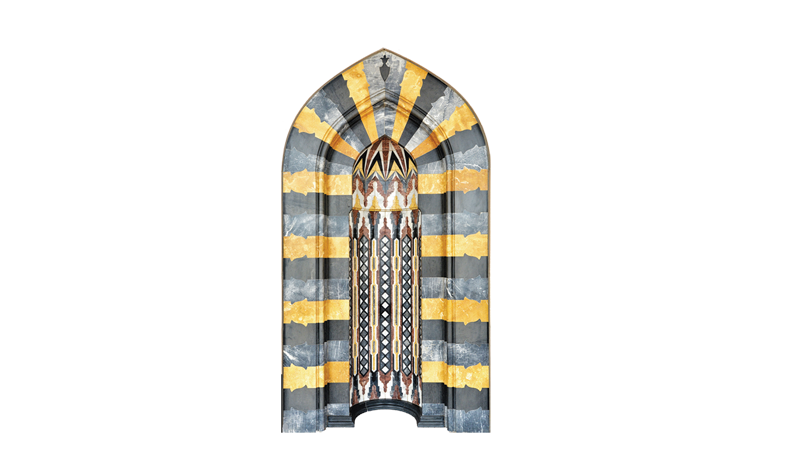

For quite some time, as I went about my daily business in Muscat, I would often find myself thinking of the Mamluks, that intriguing slave-dynasty that ruled Egypt and Syria in the Medieval Islamic period. There I would be, for example, driving through Al Khuwair with my son to buy a couple of shish tawook sandwiches for dinner, when suddenly I would be wondering what it must have felt like being a boy from the Russian Step, sold into slavery, trained in warfare and serving in the vast Muslim army that finally halted the Mongul sweep across Asia at the Battle of Ain Jalut in 1260 CE. Just what was it that prompted such reveries?
Then one day last year, as we waited in a long line of traffic for a dignitary to pass on the highway, I spent a few minutes admiring a newly built mosque by the side of the road, with its elegant proportions and ablaq decorations above the windows and portals. Suddenly, I found myself wandering, in my mind’s eye, through the massive Mosque-Madrassah of Sultan Hassan, located in the Citadel of Cairo.
“That’s it!” I shouted, causing my son to jump in his seat. “The reason the Mamluks are so often on my mind is because of all the ablaq to be seen on public buildings in Muscat.” My son is mute and so could only respond with a look that suggested he thought me a nincompoop!
The sight of ablaq was, I realised, the trigger for long forgotten memories of a paper I once wrote for an Art History module on Mamluk Art and Architecture to resurface into my consciousness. So, as 2017 is the 500th anniversary of the downfall of the Mamluks, I thought it might be fun to remind ourselves of that fascinating dynasty and to look more closely at the decorative technique of ablaq that they greatly favoured in their architecture.
The word ‘mamluk’ was an Arabic term for a slave from the Russian Step who had been captured or sold into slavery as a boy and trained in the art of warfare to serve as slave soldiers of the Ayyubid Sultans, a dynasty founded by Saladin in the 12th century. By 1250 CE, their power was such that they were able to depose and appoint sultans and by 1260 CE, with the Ayyubid Empire on the verge of collapse from the Mongol onslaught, they usurped the royal right and installed Baybars, the victor over the Mongols at the Battle of Ayn Jalut, as the first Mamluk Sultan. Their dynasty was to last for the next 250 years until being superseded by the Ottomans on 1517 CE.
The Mamluk Sultans had a liking for grand public buildings, such as the magnificent Mosque/Madrassah of Sultan Hassan in the Citadel of Cairo, as well as the more private though no less grand mausolea which can still be seen in the Mamluk cemetery. Three decorative features are common to these Mamluk edifices, setting them apart from the buildings of their Ayyubid predecessors — heraldic blazons, monumental calligraphy in Naskhi script and the use of ablaq, particularly as a surround for portals, windows and maharib.
Ablaq, an Arabic word literally meaning ‘piebald’, is a style of architectural revetment composed of alternating layers of different colours or shades of masonry. Although the term was first coined in the 11th century to describe renovations to the Umayyad Mosque in Damascus, ablaq evolved much earlier and may have its origins in Andalucía. Those of us who have been lucky enough to visit Cordoba will have seen magnificent examples of ablaq in the horseshoe arches of the Grand Mosque there, which dates from the late 10th century CE.
If you wish to see ablaq in Muscat, then you are fortunate as it is widely used to beautiful effect on mosques and other public buildings. However, there is no better place to appreciate its striking and confident beauty than in the north cloister of the Sultan Qaboos Grand Mosque in Bausher, where six superb arches offer the spectator a tour in miniature of the various techniques employed by the Mamluks. It is my pleasure to be able to include a photograph of one of them here, which clearly echoes the ablaq of the Mamluk Period, such as can be seen in the Mosque of Baybars and the Sultan Hassan Mosque/Madrassah in Cairo.
So, as you drive around Muscat, keep an eye open for the many examples of ablaq to be seen and, who knows, maybe soon you too will find yourself transported back to the Mamluk Period. It’s a great way to while away the time when stuck in traffic! And if by some unfortunate fluke you have not yet visited the Sultan Qaboos Grand Mosque, I heartily recommend you do so and enjoy the wonderful examples of Islamic Art to be seen there. It is open to the general public from 8.30 am to 11 am, Saturday to Thursday.
Clive Gracey
www.clivegracey.squarespace.com
Oman Observer is now on the WhatsApp channel. Click here



